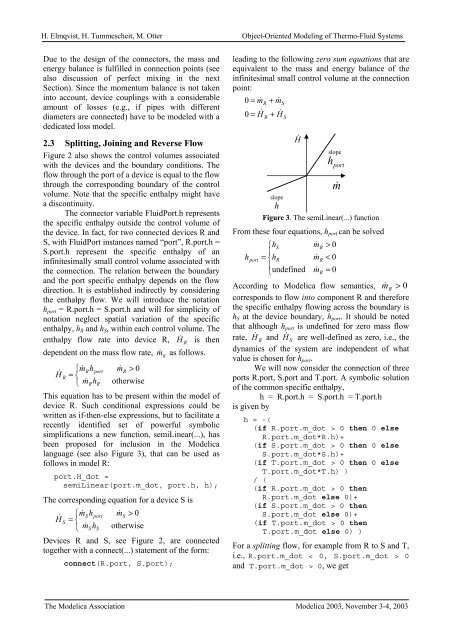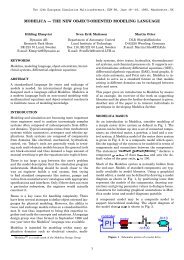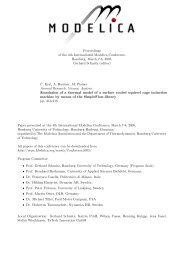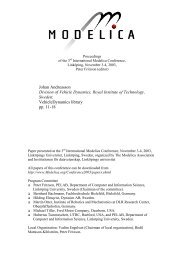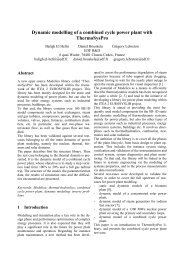Hilding Elmqvist, Hubertus Tummescheit and Martin Otter ... - Modelica
Hilding Elmqvist, Hubertus Tummescheit and Martin Otter ... - Modelica
Hilding Elmqvist, Hubertus Tummescheit and Martin Otter ... - Modelica
You also want an ePaper? Increase the reach of your titles
YUMPU automatically turns print PDFs into web optimized ePapers that Google loves.
H. <strong>Elmqvist</strong>, H. <strong>Tummescheit</strong>, M. <strong>Otter</strong> Object-Oriented Modeling of Thermo-Fluid Systems<br />
Due to the design of the connectors, the mass <strong>and</strong><br />
energy balance is fulfilled in connection points (see<br />
also discussion of perfect mixing in the next<br />
Section). Since the momentum balance is not taken<br />
into account, device couplings with a considerable<br />
amount of losses (e.g., if pipes with different<br />
diameters are connected) have to be modeled with a<br />
dedicated loss model.<br />
2.3 Splitting, Joining <strong>and</strong> Reverse Flow<br />
Figure 2 also shows the control volumes associated<br />
with the devices <strong>and</strong> the boundary conditions. The<br />
flow through the port of a device is equal to the flow<br />
through the corresponding boundary of the control<br />
volume. Note that the specific enthalpy might have<br />
a discontinuity.<br />
The connector variable FluidPort.h represents<br />
the specific enthalpy outside the control volume of<br />
the device. In fact, for two connected devices R <strong>and</strong><br />
S, with FluidPort instances named “port”, R.port.h =<br />
S.port.h represent the specific enthalpy of an<br />
infinitesimally small control volume associated with<br />
the connection. The relation between the boundary<br />
<strong>and</strong> the port specific enthalpy depends on the flow<br />
direction. It is established indirectly by considering<br />
the enthalpy flow. We will introduce the notation<br />
hport = R.port.h = S.port.h <strong>and</strong> will for simplicity of<br />
notation neglect spatial variation of the specific<br />
enthalpy, hR <strong>and</strong> hS, within each control volume. The<br />
enthalpy flow rate into device R, H R<br />
& is then<br />
dependent on the mass flow rate, m& as follows.<br />
R<br />
H&<br />
R<br />
⎧ m&<br />
Rh<br />
port m&<br />
R > 0<br />
= ⎨<br />
⎩ m&<br />
RhR<br />
otherwise<br />
This equation has to be present within the model of<br />
device R. Such conditional expressions could be<br />
written as if-then-else expressions, but to facilitate a<br />
recently identified set of powerful symbolic<br />
simplifications a new function, semiLinear(...), has<br />
been proposed for inclusion in the <strong>Modelica</strong><br />
language (see also Figure 3), that can be used as<br />
follows in model R:<br />
port.H_dot =<br />
semiLinear(port.m_dot, port.h, h);<br />
The corresponding equation for a device S is<br />
⎧ m&<br />
Sh<br />
port m&<br />
S > 0<br />
H&<br />
S = ⎨<br />
⎩ m&<br />
ShS<br />
otherwise<br />
Devices R <strong>and</strong> S, see Figure 2, are connected<br />
together with a connect(...) statement of the form:<br />
connect(R.port, S.port);<br />
leading to the following zero sum equations that are<br />
equivalent to the mass <strong>and</strong> energy balance of the<br />
infinitesimal small control volume at the connection<br />
point:<br />
0 = m&<br />
R + m&<br />
S<br />
0 = H&<br />
+ H&<br />
R<br />
S<br />
Figure 3. The semiLinear(...) function<br />
From these four equations, hport can be solved<br />
h<br />
port<br />
H &<br />
⎧hS<br />
⎪<br />
= ⎨hR<br />
⎪<br />
⎩undefined<br />
m&<br />
m&<br />
m&<br />
R<br />
R<br />
R<br />
> 0<br />
< 0<br />
= 0<br />
port<br />
According to <strong>Modelica</strong> flow semantics, m& R > 0<br />
corresponds to flow into component R <strong>and</strong> therefore<br />
the specific enthalpy flowing across the boundary is<br />
hS at the device boundary, hport. It should be noted<br />
that although hport is undefined for zero mass flow<br />
rate, R H& <strong>and</strong> S H& are well-defined as zero, i.e., the<br />
dynamics of the system are independent of what<br />
value is chosen for hport.<br />
We will now consider the connection of three<br />
ports R.port, S.port <strong>and</strong> T.port. A symbolic solution<br />
of the common specific enthalpy,<br />
h = R.port.h = S.port.h = T.port.h<br />
is given by<br />
h = -(<br />
(if R.port.m_dot > 0 then 0 else<br />
R.port.m_dot*R.h)+<br />
(if S.port.m_dot > 0 then 0 else<br />
S.port.m_dot*S.h)+<br />
(if T.port.m_dot > 0 then 0 else<br />
T.port.m_dot*T.h) )<br />
/ (<br />
(if R.port.m_dot > 0 then<br />
R.port.m_dot else 0)+<br />
(if S.port.m_dot > 0 then<br />
S.port.m_dot else 0)+<br />
(if T.port.m_dot > 0 then<br />
T.port.m_dot else 0) )<br />
For a splitting flow, for example from R to S <strong>and</strong> T,<br />
i.e., R.port.m_dot < 0, S.port.m_dot > 0<br />
<strong>and</strong> T.port.m_dot > 0, we get<br />
The <strong>Modelica</strong> Association <strong>Modelica</strong> 2003, November 3-4, 2003<br />
slope<br />
h<br />
slope<br />
h<br />
m&


